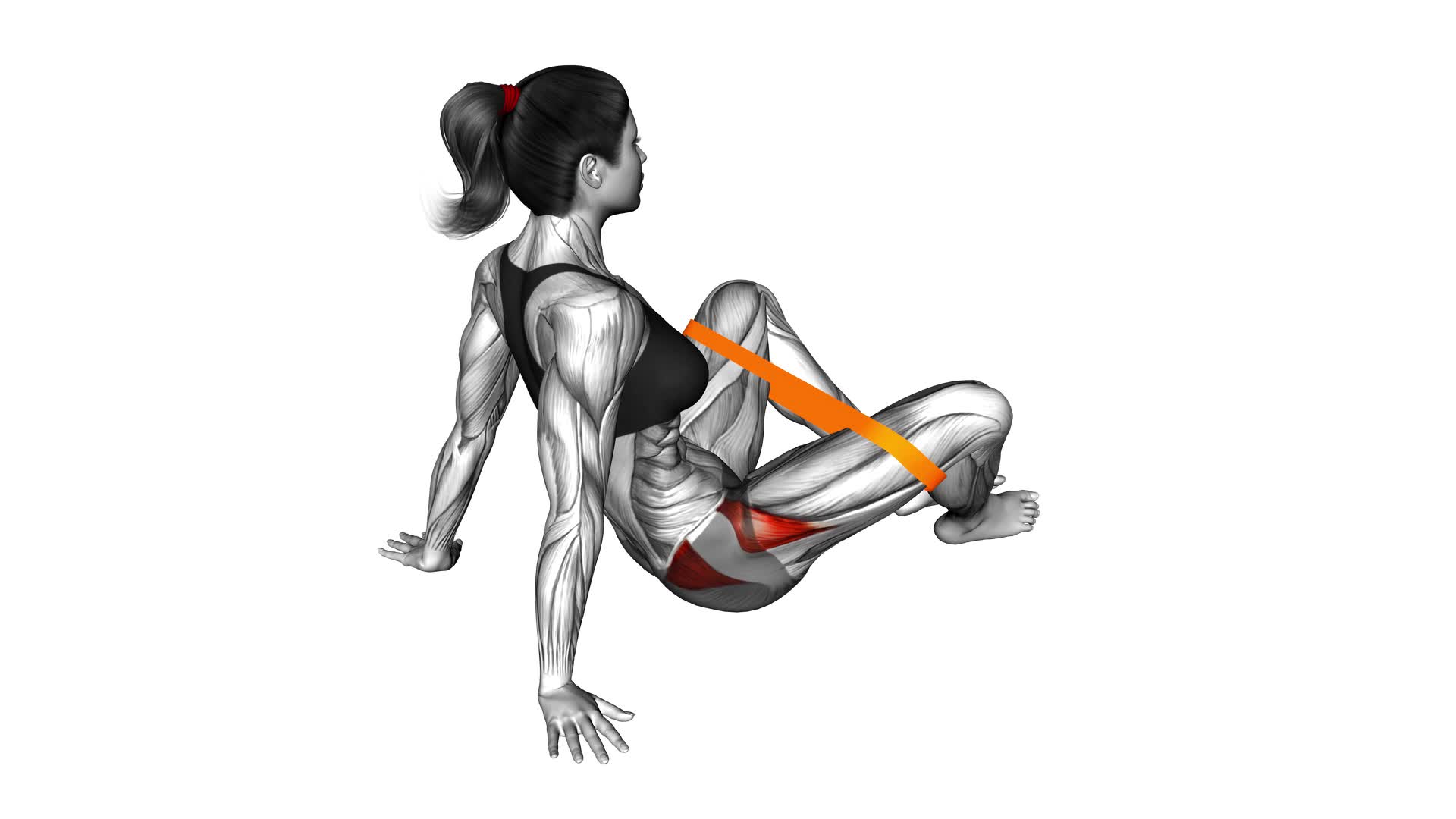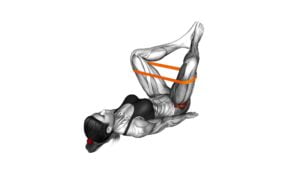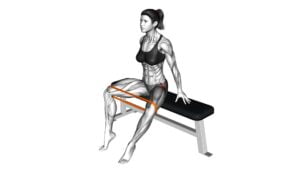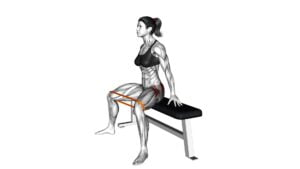Resistance Band Seated Bent Knee Abduction (female) – Video Exercise Guide & Tips

Are you looking to tone and strengthen your lower body muscles? If so, resistance band seated bent knee abduction is the perfect exercise for you.
Watch This Exercise Video
With just a resistance band and a chair, you can target your glutes and outer thighs effectively.
In this video exercise guide, we will show you the proper form and technique, as well as provide tips to maximize the effectiveness of this exercise.
Get ready to feel the burn and achieve your fitness goals!
Key Takeaways
- Targets hip abductor muscles
- Improves lower body stability and balance
- Helps prevent injuries such as hip bursitis or IT band syndrome
- Enhances athletic performance
Benefits of Resistance Band Seated Bent Knee Abduction
You will experience multiple benefits from incorporating resistance band seated bent knee abduction into your workout routine. This exercise specifically targets your hip abductor muscles, which are responsible for moving your legs away from the midline of your body. By strengthening these muscles, you can improve your overall lower body stability and balance.
One of the main benefits of resistance band seated bent knee abduction is that it helps to prevent injuries. Strong hip abductors can help stabilize your hips and pelvis, reducing the risk of common injuries such as hip bursitis or iliotibial (IT) band syndrome.
Additionally, this exercise can improve your athletic performance. Strong hip abductors are essential for movements like running, jumping, and lateral movements. By incorporating resistance band seated bent knee abduction into your routine, you can enhance your power, speed, and agility.
Furthermore, resistance band seated bent knee abduction can be modified to meet your specific needs. If you're a beginner, you can start with a lighter resistance band or perform the exercise without any resistance at all. As you progress, you can gradually increase the resistance to continue challenging your muscles.
Equipment Needed for the Exercise
To perform the resistance band seated bent knee abduction exercise, you'll need a resistance band. Resistance bands are versatile and affordable pieces of equipment that can be used for various resistance band exercises. They're particularly useful for strengthening hip muscles, which is the main focus of the seated bent knee abduction exercise.
When choosing a resistance band, make sure it's the right level of resistance for your fitness level. Resistance bands come in different colors or levels of resistance, ranging from light to heavy. Beginners may want to start with a lighter resistance band and gradually progress to a heavier one as they build strength.
In addition to the resistance band, you may also need a chair or bench to sit on while performing the exercise. Make sure the chair or bench is sturdy and stable to avoid any accidents or injuries.
Before starting the exercise, it's important to properly anchor the resistance band. You can either tie it to a stationary object or loop it around your feet and hold onto the ends. Ensure that the band is secure and won't come loose during the exercise.
Proper Form and Technique for Seated Bent Knee Abduction
Proper form and technique are crucial for maximizing the effectiveness of the seated bent knee abduction exercise with a resistance band. To ensure proper form and technique, follow these steps:
- Sit on a sturdy chair with your back straight and feet flat on the floor.
- Place the resistance band around your thighs, just above your knees.
- Keep your knees bent at a 90-degree angle and your feet hip-width apart.
- Engage your core and maintain a neutral spine throughout the exercise.
To perform the exercise:
- Slowly and with control, press your knees outwards against the resistance of the band.
- Release back to the starting position.
To avoid common mistakes:
- Avoid rounding your back.
- Avoid allowing your knees to collapse inward.
- Avoid using momentum to complete the movement.
For beginners, modifications can be made:
- Use a lighter resistance band.
- Reduce the range of motion.
Always listen to your body and stop if you feel any pain or discomfort. By following these guidelines, you can ensure proper form and technique for the seated bent knee abduction exercise with a resistance band.
Tips to Maximize the Effectiveness of the Exercise
To maximize the effectiveness of the seated bent knee abduction exercise with a resistance band, focus on maintaining proper alignment and engaging the targeted muscles. This will help you get the most out of your workout and prevent any potential injuries.
One common mistake to avoid is allowing your knees to collapse inward during the movement. Keep your knees in line with your hips and ankles, maintaining a strong and stable position. This will ensure that you're targeting the correct muscles and maximizing the effectiveness of the exercise.
Another important tip is to engage your core throughout the movement. By activating your core muscles, you won't only improve your stability but also enhance the effectiveness of the exercise.
When it comes to sets and reps, it's recommended to start with 2-3 sets of 10-15 repetitions. This will provide a good starting point for beginners. As you progress, you can gradually increase the number of sets and reps to continue challenging your muscles.
Remember to listen to your body and adjust the resistance level of the band accordingly. You should feel a moderate level of resistance, but not to the point where it causes pain or discomfort. By following these tips and recommendations, you can maximize the effectiveness of the seated bent knee abduction exercise and achieve your fitness goals.
Variations and Progressions for Advanced Users
For advanced users, you can further challenge yourself with variations and progressions of the seated bent knee abduction exercise using a resistance band. These variations and modifications will help you continue to build strength and improve your overall fitness level.
One variation you can try is increasing the resistance of the band. This can be achieved by using a thicker band or multiple bands at once. By increasing the resistance, you'll be putting more stress on your hip abductors, forcing them to work harder.
Another variation is to incorporate a hold at the top of the movement. Instead of simply returning to the starting position after each repetition, hold your leg in the fully abducted position for a few seconds before lowering it back down. This will further engage your muscles and increase the intensity of the exercise.
Additionally, you can try performing the exercise in a standing position instead of seated. This will require more stabilization from your core and leg muscles, providing a greater challenge.
Frequently Asked Questions
How Long Should I Hold the Contraction During the Seated Bent Knee Abduction Exercise?
During the seated bent knee abduction exercise, the length of contraction will depend on your fitness level and goals. For beginners, holding the contraction for 10-15 seconds is a good starting point. As you progress, you can increase the duration to 20-30 seconds or even longer.
It's important to listen to your body and not push yourself too hard. Remember, there are variations of seated bent knee abduction that you can explore to add variety to your workout routine.
Can I Perform the Exercise Without Using a Resistance Band?
Yes, you can perform the seated bent knee abduction exercise without using a resistance band. However, using a resistance band offers added benefits.
It increases resistance, making the exercise more challenging and effective for targeting the hip abductor muscles.
If you don't have a resistance band, you can try alternative exercises like side-lying leg lifts or clamshells to engage the same muscle group.
Remember to maintain proper form and gradually increase the intensity for optimal results.
Is This Exercise Suitable for Individuals With Knee Injuries or Knee Pain?
If you have knee injuries or pain, it's important to consider suitable exercises for knee rehabilitation. This exercise, the Resistance Band Seated Bent Knee Abduction, may not be the best choice for you.
However, there are alternative exercises you can try that focus on strengthening the muscles around the knee without putting too much strain on it.
It's always recommended to consult with a healthcare professional to determine the best exercises for your specific condition.
How Many Repetitions and Sets Should I Do for Optimal Results?
For optimal results with seated bent knee abduction using a resistance band, it's recommended to perform 2-3 sets of 10-15 repetitions. This will help target and strengthen the muscles of the hips and thighs.
Variations of this exercise can include adjusting the resistance of the band or changing the position of your legs. Remember to start with a lighter resistance and gradually increase as you build strength.
Are There Any Specific Breathing Techniques I Should Follow During the Exercise?
When performing the Resistance Band Seated Bent Knee Abduction, it's important to focus on your breathing techniques. Take a deep breath in as you prepare to start the exercise, and exhale as you lift your leg out to the side. This helps engage your core and stabilize your body.
Remember to breathe out fully and inhale deeply with each repetition. If you feel any discomfort, modify the exercise by using a lighter resistance band or reducing the range of motion.
Conclusion
In conclusion, the resistance band seated bent knee abduction is a highly effective exercise for targeting the muscles in the hips and thighs.
By using a resistance band, you can increase the intensity and challenge of the exercise, leading to greater muscle activation and strength gains.
By following the proper form and technique, and incorporating the tips mentioned, you can maximize the effectiveness of this exercise and achieve your fitness goals.
Remember to always consult with a professional before starting any new exercise routine.

Author
Years ago, the spark of my life’s passion ignited in my mind the moment I stepped into the local gym for the first time. The inaugural bead of perspiration, the initial endeavor, the very first surge of endorphins, and a sense of pride that washed over me post-workout marked the beginning of my deep-seated interest in strength sports, fitness, and sports nutrition. This very curiosity blossomed rapidly into a profound fascination, propelling me to earn a Master’s degree in Physical Education from the Academy of Physical Education in Krakow, followed by a Sports Manager diploma from the Jagiellonian University. My journey of growth led me to gain more specialized qualifications, such as being a certified personal trainer with a focus on sports dietetics, a lifeguard, and an instructor for wellness and corrective gymnastics. Theoretical knowledge paired seamlessly with practical experience, reinforcing my belief that the transformation of individuals under my guidance was also a reflection of my personal growth. This belief holds true even today. Each day, I strive to push the boundaries and explore new realms. These realms gently elevate me to greater heights. The unique combination of passion for my field and the continuous quest for growth fuels my drive to break new ground.







